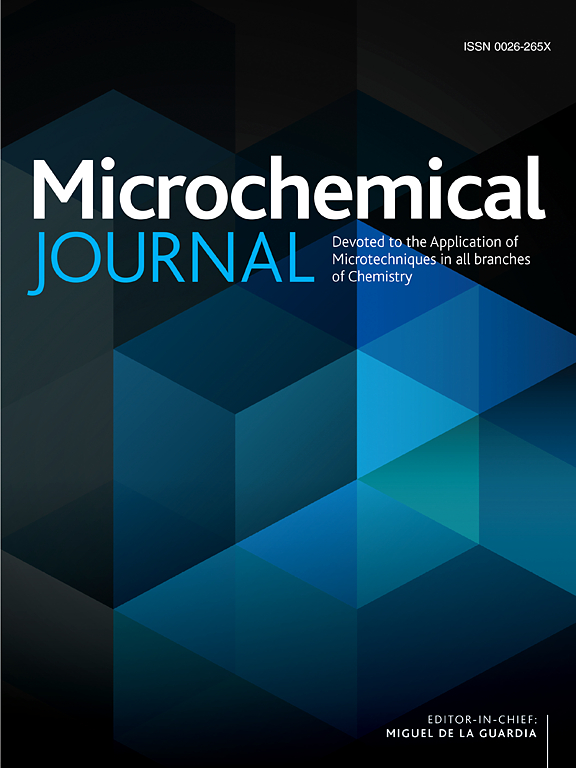Implementation of a carbon electrode-based sensor for monitoring the physicochemical quality in the production of Tequila Rosado
IF 4.9
2区 化学
Q1 CHEMISTRY, ANALYTICAL
引用次数: 0
Abstract
Tequila Rosado, an innovative beverage whose main appeal is its pink hue, in some cases it can be prepared by infusing Tequila 100 % Agave Silver Class (T100%-SC) with Hibiscus Flowers (T100%-SC-HF) or aging in Wine Barrels (T100%-SC-WB). Given the impact of these processes on its physicochemical properties, it is essential to analyze its characteristics to ensure optimal quality. This study focuses on the electrochemical characterization of color in Tequila Rosado, using emerging analytical techniques to assess color variations based on production methods. While no statistically significant differences were found in the levels of methanol, higher alcohols, esters, aldehydes, furfural, δ13CVPDB, and δ18OVSMOW compared to Tequila 100 % Agave Silver Class, production processes significantly alter the color profile. Image analysis with RGB and HSV models showed an increase in red tones, generating shades of pink and beige. UV–Vis spectroscopy supports these findings, showing a band at 530 nm in T100%-SC-HF, associated with natural hibiscus pigments, and a band at 365 nm in T100%-SC-WB, typical of aged Tequilas. However, the most notable aspect is the use of electrochemical techniques, such as Differential Pulse Voltammetry (DPV), which allows precise evaluation of the color index. Electrochemical results show that color differences correlate with manufacturing processes, reflecting the oxidation signals of phenolic compounds, flavonoids, anthocyanins, and tannins present in hibiscus flowers and wine barrels. These electrochemical measurements provide a robust and emerging tool for characterizing the coloration in beverages like Tequila Rosado.

用于监测龙舌兰酒生产过程中理化质量的碳电极传感器的实现
龙舌兰酒是一种创新饮料,其主要吸引力在于其粉红色的色调,在某些情况下,它可以通过将龙舌兰酒100%龙舌兰银级(T100%-SC)与芙蓉花(T100%-SC- hf)混合或在酒桶中陈酿(T100%-SC- wb)来制备。考虑到这些过程对其物理化学性质的影响,分析其特性以确保最佳质量是必要的。本研究的重点是龙舌兰酒颜色的电化学表征,利用新兴的分析技术来评估基于生产方法的颜色变化。虽然与100%龙舌兰银级龙舌兰酒相比,甲醇、高级醇、酯类、醛类、糠醛、δ13CVPDB和δ18OVSMOW的含量没有统计学上的显著差异,但生产过程显著改变了颜色轮廓。用RGB和HSV模型进行的图像分析显示,红色色调有所增加,产生了粉红色和米色的阴影。紫外可见光谱支持这些发现,在T100%-SC-HF中显示530 nm的波段,与天然木芙蓉色素有关,而在T100%-SC-WB中显示365 nm的波段,这是陈年龙舌兰酒的典型特征。然而,最值得注意的方面是电化学技术的使用,如差分脉冲伏安法(DPV),它可以精确地评估颜色指数。电化学结果表明,颜色差异与制造过程有关,反映了木槿花和酒桶中酚类化合物、类黄酮、花青素和单宁的氧化信号。这些电化学测量为表征龙舌兰酒等饮料的颜色提供了一种强大的新兴工具。
本文章由计算机程序翻译,如有差异,请以英文原文为准。
求助全文
约1分钟内获得全文
求助全文
来源期刊

Microchemical Journal
化学-分析化学
CiteScore
8.70
自引率
8.30%
发文量
1131
审稿时长
1.9 months
期刊介绍:
The Microchemical Journal is a peer reviewed journal devoted to all aspects and phases of analytical chemistry and chemical analysis. The Microchemical Journal publishes articles which are at the forefront of modern analytical chemistry and cover innovations in the techniques to the finest possible limits. This includes fundamental aspects, instrumentation, new developments, innovative and novel methods and applications including environmental and clinical field.
Traditional classical analytical methods such as spectrophotometry and titrimetry as well as established instrumentation methods such as flame and graphite furnace atomic absorption spectrometry, gas chromatography, and modified glassy or carbon electrode electrochemical methods will be considered, provided they show significant improvements and novelty compared to the established methods.
 求助内容:
求助内容: 应助结果提醒方式:
应助结果提醒方式:


